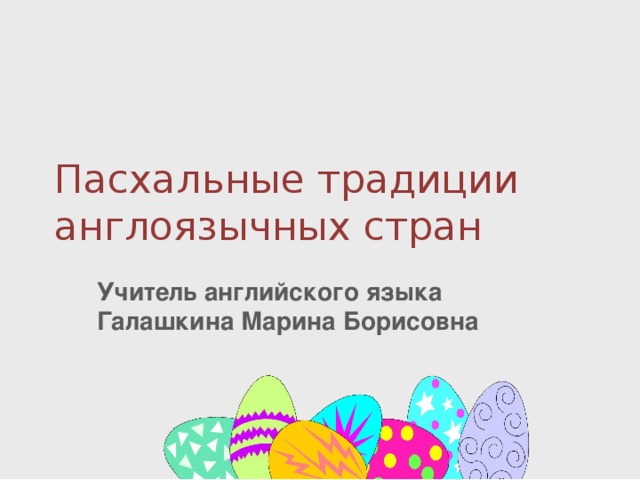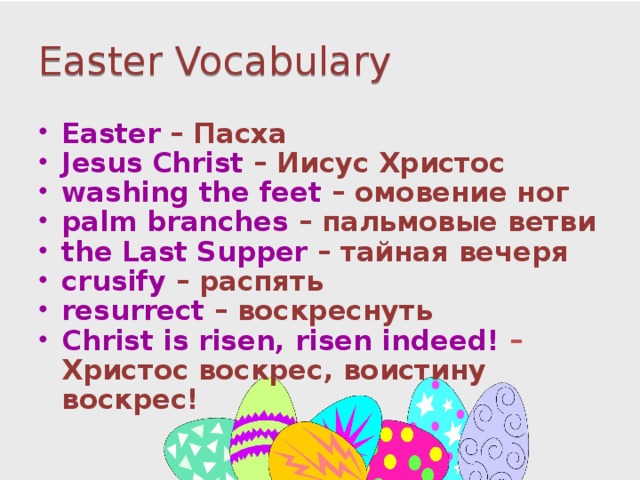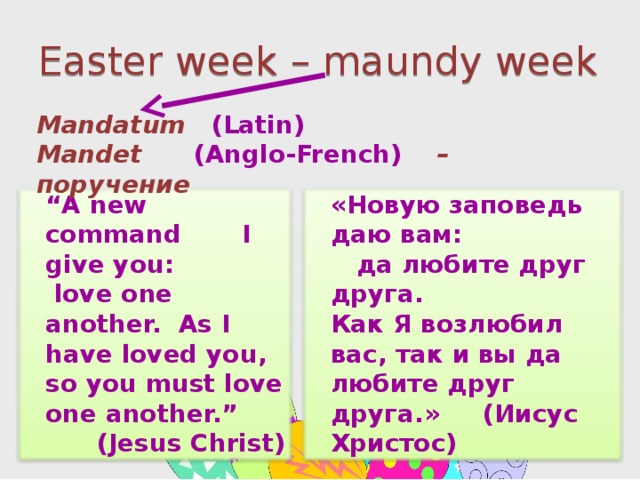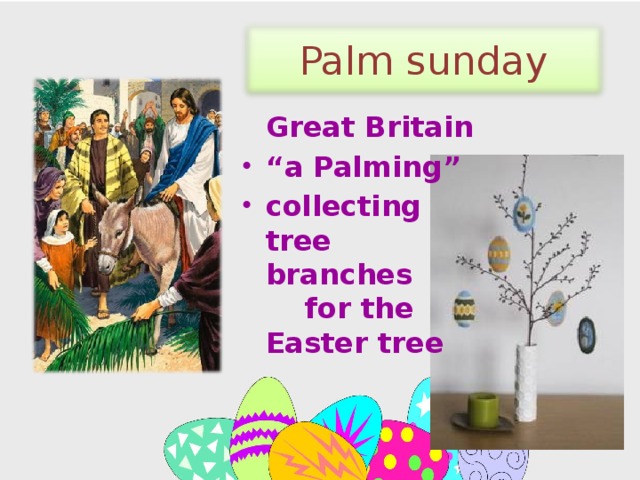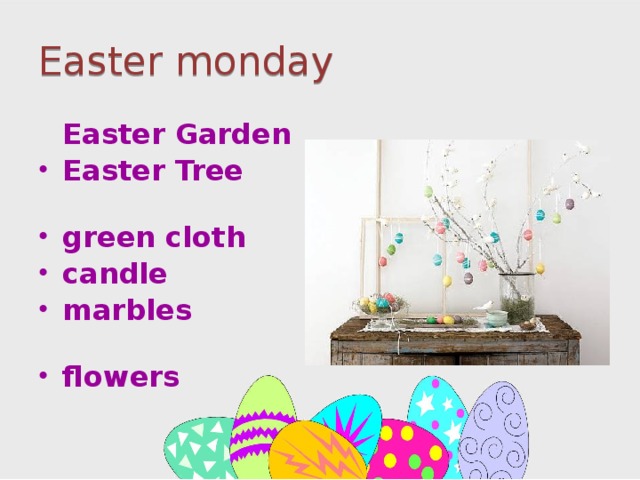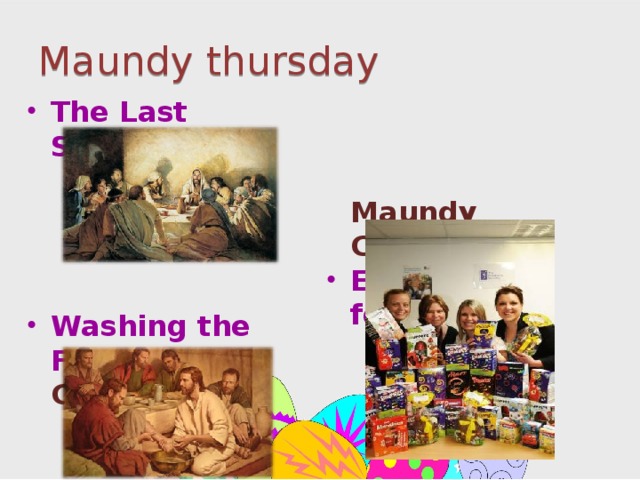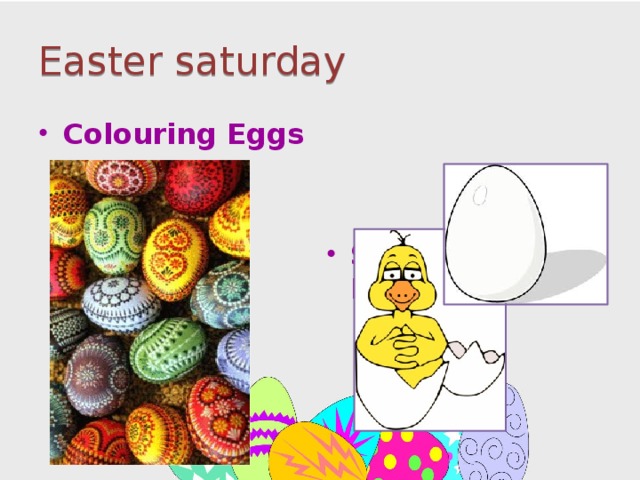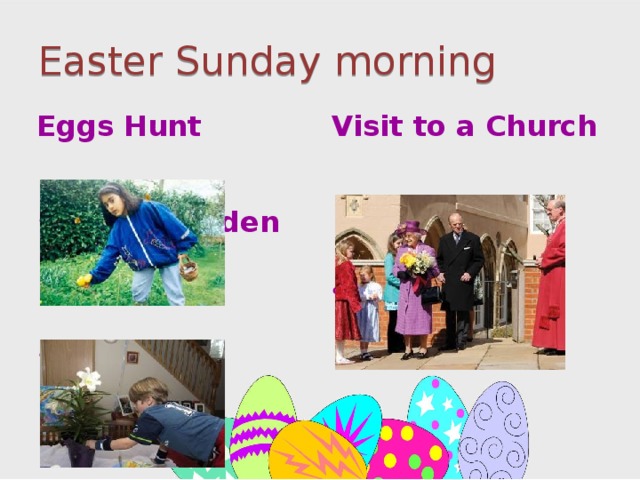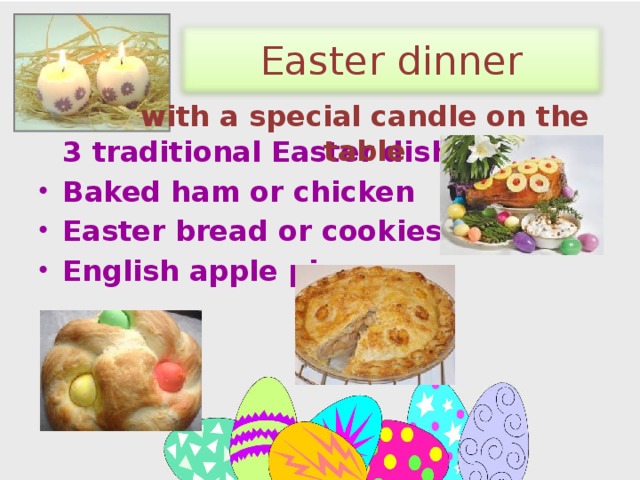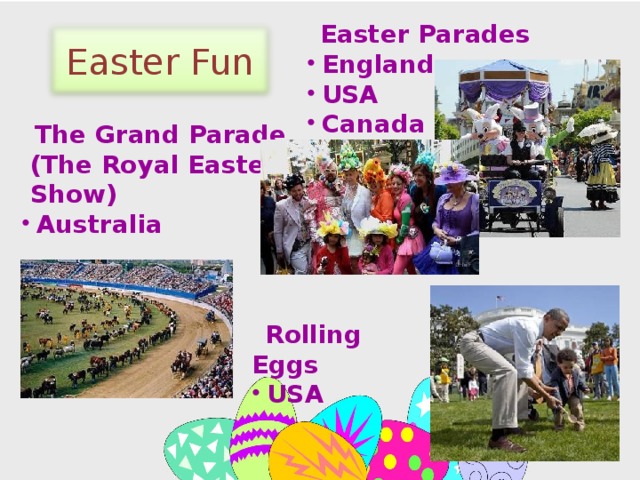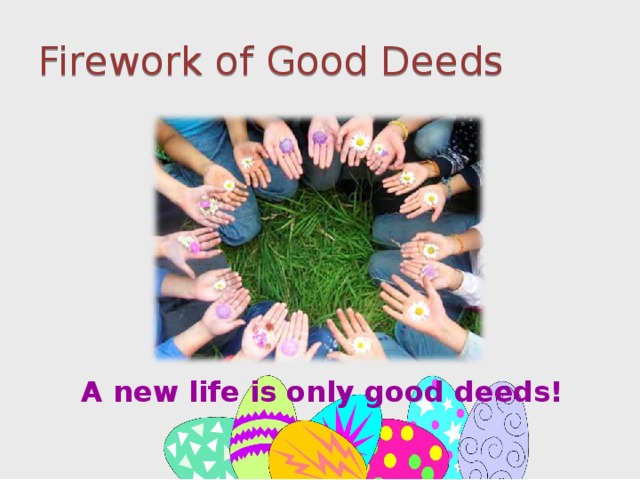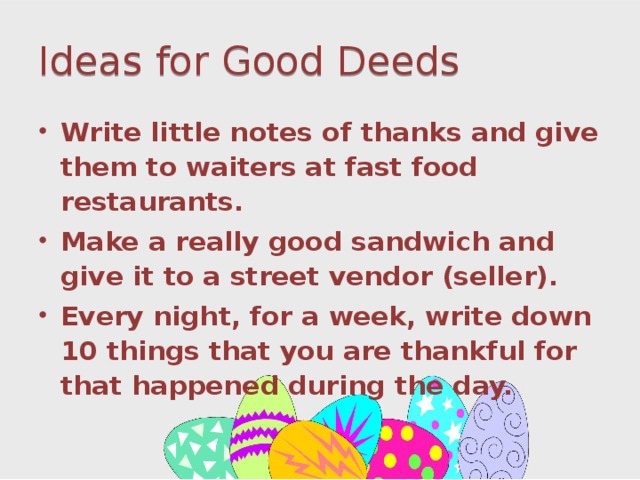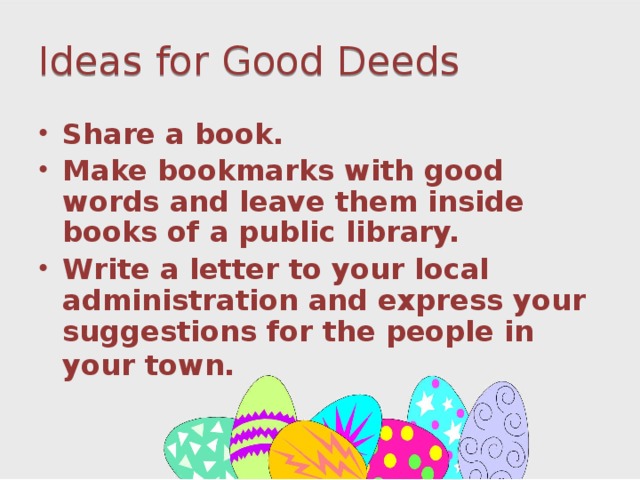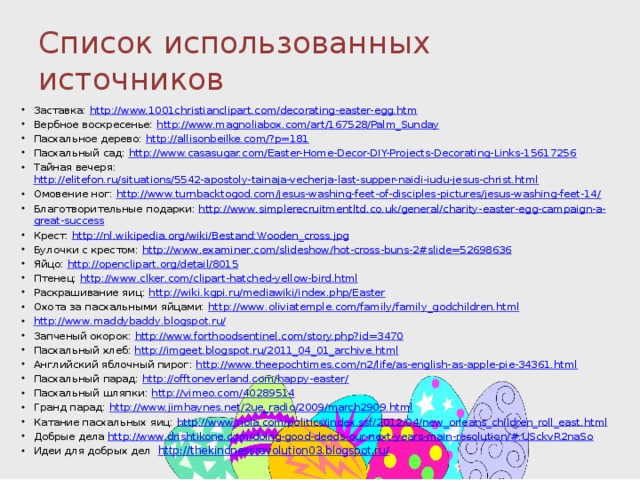Галашкина Марина Борисовна
учитель английского языка
Сценарий пасхальной игры-конкурса
«Традиции празднования Пасхи в англоязычном мире»
на английском языке
1. You’re welcome to our Easter Party. You’ll see how Easter is celebrated in English-speaking countries. We hope you’ll enjoy our Easter contest.
Here are some words you will need to know when you hear or talk about Easter in English.
Easter Week is called Maundy Week in the English-speaking world. This name comes from the Latin word “mandatum”, In Anglo-French it is “mandet”.
Maunde ceremony is a ceremony of washing the feet of the poor on Maundy Thursday.
. Jesus said, “A new command I give you: love one another. As I have loved you, so you must love one another.”
On Palm Sunday (the 1st Sunday before Easter) or 2-3 days before people in GB gather branches for Easter Tree. This event is called “a Palming” in memory of the fact that about 2000 years ago a week before Easter people in Jerusalem greeted Jesus laying branches of palms on the road where He was entering that city to die on the Cross.
Task 1. We invite one student from each team to come here and choose 3 branches. In your groups then you are welcome to make Easter Trees.
On Monday they decorate their Easter Trees.
Task 2. Now we want you to decorate your trees with the eggs that you have prepared.
Then they make Easter Garden out of some special things.
Task 3. Here are lists with the things for Easter Garden. We invite one student from each team to come here. You are welcome to find the things on the table as quickly as possible and make your gardens in the groups.
On Maundy Thursday the Last Supper of Jesus Christ is celebrated. On this day in GB rich people give gifts to the poor.
Task 4. We invite one student from each team to come here. In your team you are welcome to choose the 3 things they give from the list and then read out aloud.
Then comes Good Friday that is also called God’s Friday. On this day of the week Christ was crusified. So it’s the saddest day of the week. In England people bake hot-cross buns. We’d like to sing the song about them with you.
On Easter Saturday they colour eggs. In GB children put the coloured eggs in green, pink, red or yellow baskets.
Task 5. It was your home task to prepare a picture for colouring Easter eggs. You are welcome to present it.
On Easter morning in the USA children get Easter baskets full of sweets, chocolates and candy eggs. Their parents hide Easter eggs all over the house or in the garden, they say that the Easter Bunny has hidden them, and the children hunt for the eggs.
Task 6. We have also hidden … eggs. You’re welcome to find them.
Then people go to church. In GB they usually put on new clothes for this occasion. Easter means the beginning of new life, because Christ is risen. They come to church to show that they understand it. After church they have Easter dinner. They put a special candle on the table.
Task 7. Can you make up (unscramble) the names of 3 traditional Easter dishes? A person from each team is invited to take an envelope with the scrambled dish names.
On Easter afternoon in England (London) and the USA (New Jersey, Atlantic City) Easter Parades are organized. People put on new clothes as a symbol of the changing seasons. During the Parade, competitions are held to find the best Easter bonnet.
Task 8. We are going to have our own competition. You’re welcome to show your wonderful bonnets and to tell us about them.
In the USA funny competitions are held. Children and grown-ups compete in rolling eggs.
Task 9. Would you like to play? One member of each team is invited. You have to roll one off the eggs from the start line to the finish line.
On Easter Monday in Sydney (Australia) the Royal Easter Show is organized. It’s an agricultural show with displays of flowers, fruit and vegetables, cattle, sheep and art and craft. There is fun-fair and firework.
We can make our firework of good ideas and good deeds in honour of the holiday and the great Commandment of Christ. Take (Look at) the lists of good deds. Which of the following things can you do to make the people around you happier?
Приложение
Hot Cross Buns
Hot cross Buns, hot cross buns, If you have no daughters, give them to your sons,
One a penny, two a penny, One a penny, two a penny,
Hot cross buns. Hot cross buns.
Maundy Week:
Monday, Tuesday, Wednesday, Maundy Thursday, Good Friday, Easter Saturday, Easter Sunday, Easter Monday
Items for Easter Garden:
Easter Tree, green cloth, candle, marbles, flowers.
Gifts for the poor:
money, food, clothes, furniture
Easter dishes:
Easter bread and cookies, Baked ham or chicken, English apple pie.
Make an Easter Garden
You will need:
* A shallow tray or dish
*Garden soil or potting compost
*Moss, cut grass or sand
*Dried twigs
*Sewing thread
*Small pot
*Flat stone large enough to cover the mouth of
the pot
*Egg cups (or other small containers)
*Small flowers
*Gravel
To Make:
1. Fill the tray with soil or potting compost.
2. Arrange it to make a hill on one side of the
tray.
3. Cover the soil with moss, grass or sand.
4. Make three crosses with dried twigs tied
together with sewing thread and place on the
hilltop.
5. Press the small pot into the hillside to make a
cave like the garden tomb. Place the stone over
the mouth of the tomb.
6. Press egg-cups full of water into the soil
around the garden and fill with flowers.
Old English apple pie
http://www.cookitsimply.com/recipe-0010-0o15351.html
There are few more delicious puddings than Old English apple pie with its filling of apples, dried fruit and spices. Serve with custard sauce, or sweetened whipped cream. Cheddar cheese is also good with apple pie.
Ingredients
225 g (1/2 lb) flour
Pinch of salt
2 tsp spoons caster sugar
100 g (4 oz) butter
2 - 3 tbsp cold water
For the filling:
3/4 kg cooking apples, peeled, cored and sliced
4 tbsp sultanas or raisins
175 g (6 oz) soft brown sugar
1/2 tsp ground cinnamon
1/4 tsp spoon grated nutmeg
Finely grated rind and juice of 1/2 lemon
To finish:
Milk
Caster sugar
Method
1. To prepare the pastry, sift the flour and salt into a mixing bowl, then stir in the sugar. Add the butter in pieces and rub into the flour with the fingertips until the mixture resembles fine breadcrumbs.
2. Stir in enough water to hold the mixture together, then form into a smooth ball. Wrap in foil or greaseproof paper and chill in the refrigerator for 30 minutes.
3. Divide the dough in two and roll out one half on a floured board to a circle to fit the base of a 20 cm (8 in) pie dish.
4. Put the apples in a mixing bowl, then stir in the remaining filling ingredients. Spoon into the dough-lined pie dish.
5. Roll out the remaining dough to a circle for the lid. Lay over the filling, pressing down and sealing the edge with water. Flute the edge with your fingers or crimp with the prongs of a fork.
6. Brush with a little milk and dredge with caster sugar. Make a slit in the centre of the pie for the steam to escape.
7. Bake on a baking sheet in the centre of a fairly hot oven (200°C/400°F or Gas Mark 6) for 15 minutes, then reduce the heat to moderate (180°C/350°F or Gas Mark 4) and continue baking for 20 minutes.
8. Allow to cool for 5 minutes before serving.
